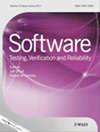Remote embedded devices test framework on the cloud
IF 1.2
4区 计算机科学
Q3 COMPUTER SCIENCE, SOFTWARE ENGINEERING
引用次数: 0
Abstract
Embedded systems have high coupling and dependency among different hardware and software components in heterogeneous layers, which makes location and issue tracking in their testing difficult. Despite these poor verification conditions, even the most important reliability quality verification among embedded system characteristics is verified with insufficient sample size, typical test cases, and general test strategies, following limitations such as development costs and scheduling. As a result, shipments are highly likely to lead to various reliability quality problems because items have not been verified considering reliability quality characteristics. Hence, to address this gap, this study developed remote embedded device test framework on the cloud (RED‐TFC), which has an innovative reliability test manager component that can automatically perform various tests for the evaluation of reliability and performance of distributed shared devices by utilizing the cloud concept. RED‐TFC offers two key enhancements over existing testing services: (i) the adaptive sample scale for reliability test (ASRT), a feature that identifies the most appropriate sample size for performing functionality and reliability tests of remote verification targets connected to the RED‐TFC server; and (ii) the mass sample reliability test (MSRT), which uses a test case that is specific to reliability, with the sample size obtained by ASRT, to perform verification following the Markov prediction process. This paper analyses two Android smartphone models considered the most generic examples, including many embedded components, and presents a method of detecting a high number of reliability problems in smartphones using the proposed RED‐TFC and its implications.远程嵌入式设备在云上测试框架
嵌入式系统在异构层中不同的硬件和软件组件之间具有高度的耦合性和依赖性,这给其测试中的定位和问题跟踪带来了困难。尽管有这些糟糕的验证条件,在嵌入式系统特性中,即使是最重要的可靠性质量验证也是用不足的样本量、典型的测试用例和一般的测试策略进行验证的,并遵循开发成本和调度等限制。因此,考虑到可靠性质量特征,货物没有经过验证,因此很有可能导致各种可靠性质量问题。因此,为了解决这一差距,本研究开发了云上远程嵌入式设备测试框架(RED‐TFC),该框架具有创新的可靠性测试管理器组件,可以利用云概念自动执行各种测试,以评估分布式共享设备的可靠性和性能。RED‐TFC在现有测试服务上提供了两个关键增强功能:(i)可靠性测试的自适应样本规模(ASRT),该功能确定了连接到RED‐TFC服务器的远程验证目标执行功能和可靠性测试的最合适样本大小;(ii)质量样本可靠性检验(MSRT),它使用特定于可靠性的测试用例,使用ASRT获得的样本量,按照马尔可夫预测过程进行验证。本文分析了两种最常见的Android智能手机模型,包括许多嵌入式组件,并提出了一种使用RED - TFC检测智能手机中大量可靠性问题的方法及其含义。
本文章由计算机程序翻译,如有差异,请以英文原文为准。
求助全文
约1分钟内获得全文
求助全文
来源期刊

Software Testing Verification & Reliability
工程技术-计算机:软件工程
CiteScore
3.70
自引率
0.00%
发文量
34
审稿时长
>12 weeks
期刊介绍:
The journal is the premier outlet for research results on the subjects of testing, verification and reliability. Readers will find useful research on issues pertaining to building better software and evaluating it.
The journal is unique in its emphasis on theoretical foundations and applications to real-world software development. The balance of theory, empirical work, and practical applications provide readers with better techniques for testing, verifying and improving the reliability of software.
The journal targets researchers, practitioners, educators and students that have a vested interest in results generated by high-quality testing, verification and reliability modeling and evaluation of software. Topics of special interest include, but are not limited to:
-New criteria for software testing and verification
-Application of existing software testing and verification techniques to new types of software, including web applications, web services, embedded software, aspect-oriented software, and software architectures
-Model based testing
-Formal verification techniques such as model-checking
-Comparison of testing and verification techniques
-Measurement of and metrics for testing, verification and reliability
-Industrial experience with cutting edge techniques
-Descriptions and evaluations of commercial and open-source software testing tools
-Reliability modeling, measurement and application
-Testing and verification of software security
-Automated test data generation
-Process issues and methods
-Non-functional testing
 求助内容:
求助内容: 应助结果提醒方式:
应助结果提醒方式:


